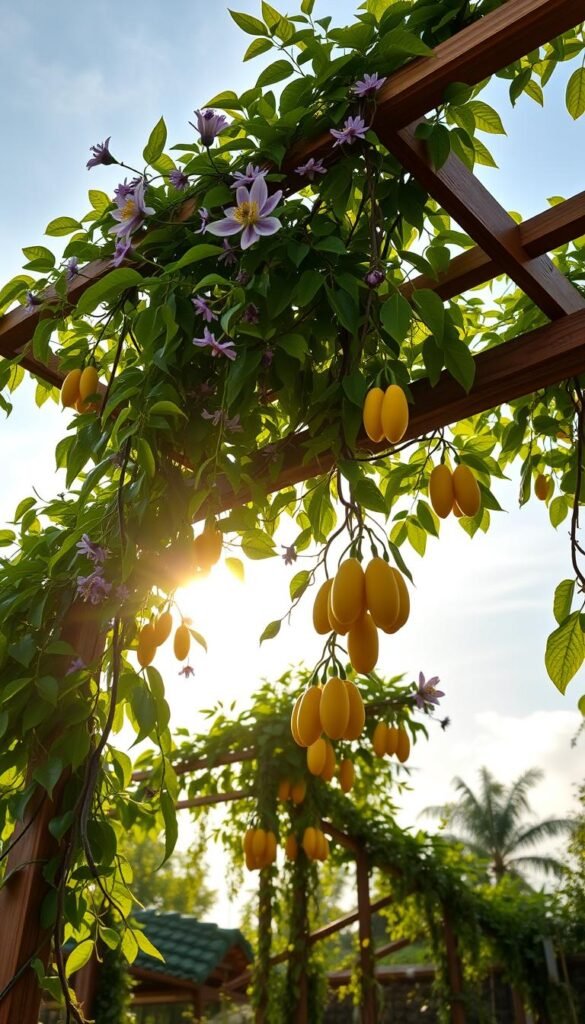Growing vibrant passion fruit vines starts with one critical choice: the right support system. These fast-growing plants demand sturdy structures to climb, bloom, and produce their signature tangy fruits. Without proper guidance, they’ll sprawl chaotically—but with thoughtful planning, you’ll unlock their full potential.
Imagine walking into your backyard to see lush green leaves cascading over a well-built frame, dotted with fragrant flowers and ripening fruit. That vision becomes reality when you match your plants’ needs to a trellis designed for longevity. Whether you’re a first-time grower or expanding an existing setup, understanding your choices ensures success.
This guide explores how different designs impact growth patterns, fruit yield, and maintenance. You’ll discover cost-effective methods using materials like bamboo or wire mesh alongside pre-made systems that save time. Location matters too—some structures thrive in compact spaces, while others suit sprawling gardens.
We’ll also cover seasonal care tips to protect your investment through harsh weather and heavy harvests. By the end, you’ll know exactly how to create a thriving environment for your vines to flourish for years.
Understand the Benefits of Trellising Your Passion Fruit Vines
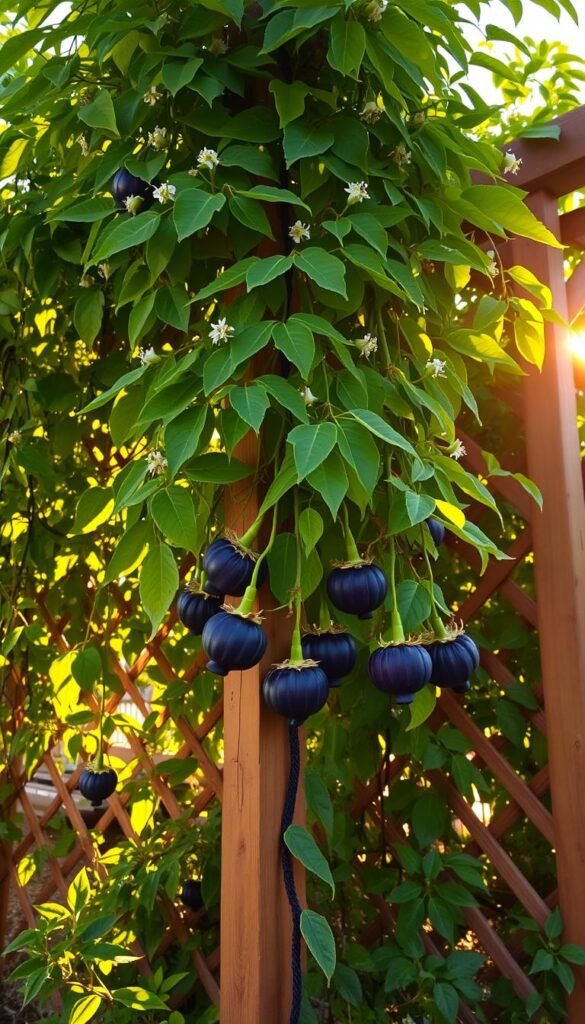
Elevating your passion fruit cultivation creates healthier growth and tastier results. Vertical gardening isn’t just space-saving—it reshapes how your plants interact with sunlight, air, and nutrients.
Enhanced Airflow and Plant Health
Vertical growth keeps leaves dry and roots strong. When vines climb upward, air moves freely around stems, stopping mold before it starts. This setup mimics their natural jungle habitat, where they’d scramble over trees.
Healthy roots anchor better in well-drained soil. With consistent watering and feeding—passion fruits are hungry plants—your trellised specimens develop thick stems that resist pests. You’ll spend less time battling mildew and more enjoying those exotic purple blooms.
Boosting Yield and Fruit Quality
Sunlight reaches every leaf when plants grow vertically. Uniform light exposure means sugars develop evenly in each fruit. You’ll notice plumper, juicier harvests with fewer misshapen or undersized specimens.
Energy that once went into sprawling across dirt now fuels flower production. A well-supported vine can bear fruit for 5-7 years in ideal conditions. Strategic pruning becomes simpler too—just follow the main stems along your structure.
Trellis Options for a Passion Fruit Garden: DIY and Store-Bought Solutions
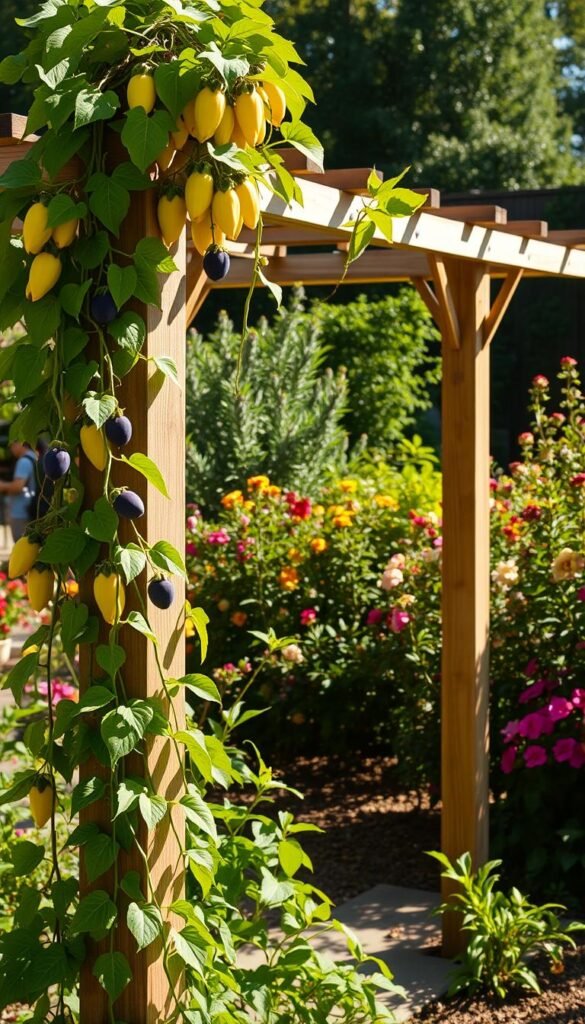
Choosing the right support for your vines opens up a world of possibilities. Both handmade and commercial systems have unique benefits, depending on your resources and gardening style.
Handcrafted Plant Supports
Transform everyday items into sturdy climbing frames. Old ladders become instant vertical growers when anchored securely. Attach chicken wire to reclaimed window frames for a rustic grid that vines cling to naturally.
Bamboo poles offer an affordable, flexible option. Create triangular teepees or rectangular grids tied with weather-resistant twine. These structures often last 3-5 years with proper care, especially in sheltered locations.
Ready-Made Growing Systems
Pre-built supports save time and guarantee durability. Powder-coated steel arches withstand heavy winds, while cedar lattices add timeless charm. Many come with ground stakes for quick installation.
Explore creative garden structures that blend function with artistry. Modular designs let you expand as your plants mature, ensuring lasting support through multiple growing seasons.
| Feature | Handmade | Commercial |
|---|---|---|
| Cost | $10-$50 | $40-$300+ |
| Materials | Upcycled items, bamboo | Treated wood, metal |
| Installation Time | 1-3 hours | 15-60 minutes |
| Lifespan | 2-5 years | 5+ years |
Your choice ultimately depends on personal preference and how quickly you need results. Whichever path you choose, proper installation ensures your plants thrive for years of fruitful harvests.
Exploring Diverse Trellis Designs for Climbing Plants
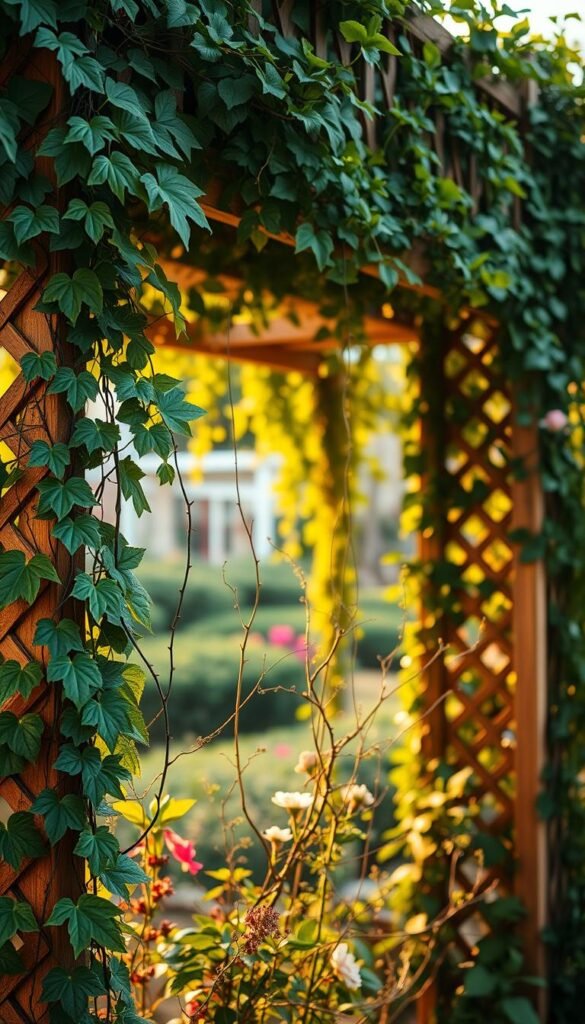
Transform your garden’s vertical spaces with artistic structures that marry form and function. Today’s supports go beyond basic grids, offering shapes that elevate your landscape while nurturing vigorous growth.
Curved, Arched, and Wavy Styles
Wave-shaped tops turn plain fences into flowing masterpieces. These organic forms guide vines gracefully while creating natural-looking boundaries. An arched design over pathways makes harvests easier and adds romantic charm.
Concave patterns work wonders in tight spaces. They draw eyes upward without overwhelming smaller gardens. Pair these styles with flowering companions like clematis for multi-season interest.
Modern Versus Rustic Aesthetics
Sleek metal frameworks shine in urban settings. Geometric patterns in powder-coated steel withstand harsh weather for 5+ years, perfect for low-maintenance spaces. Their minimalist lines let vibrant foliage take center stage.
Weathered wood lattices bring countryside warmth to suburban yards. Handcrafted willow or cedar supports age beautifully, blending with mature trees and perennial beds. Choose materials that complement your home’s exterior for cohesive curb appeal.
| Feature | Modern Design | Rustic Design |
|---|---|---|
| Materials | Steel, aluminum | Reclaimed wood, branches |
| Visual Impact | Bold geometrics | Organic textures |
| Best For | Urban gardens | Cottage landscapes |
| Lifespan | 7-10 years | 3-5 years |
Consider your location‘s climate when selecting materials. Coastal areas benefit from corrosion-resistant metals, while forested regions harmonize with wooden elements. Either choice creates lasting beauty when properly maintained.
Support Structures: Why Your Vines Need a Solid Trellis
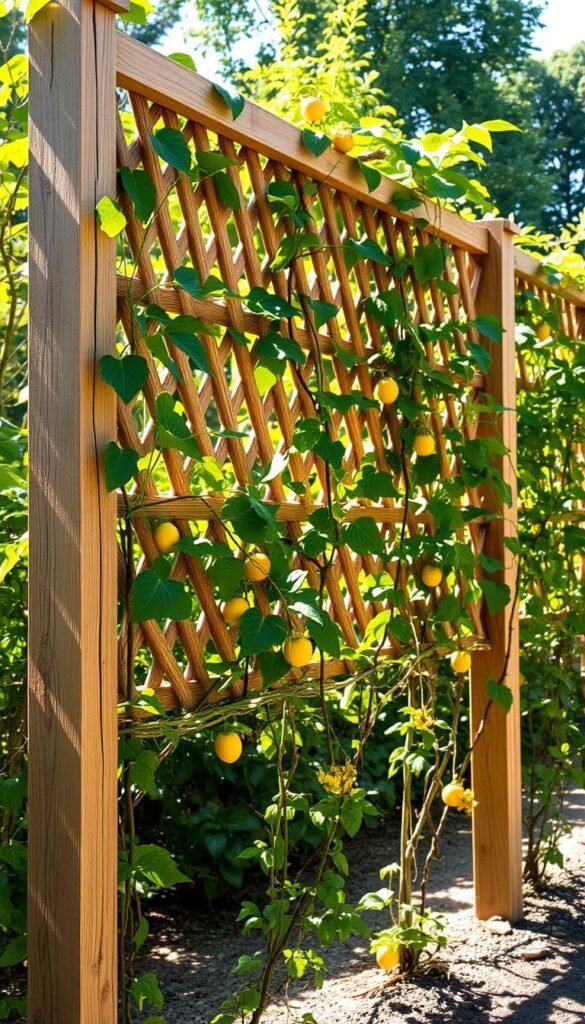
Your passion fruit’s success hinges on choosing supports that handle their explosive growth. These plants aren’t delicate climbers—they’re heavyweight producers needing military-grade infrastructure to thrive through seasons.
Ground sprawl invites trouble. Leaves touching soil become pest buffets, while trapped moisture breeds root rot. A proper framework lifts stems upward, creating airflow highways that keep diseases at bay.
Ensuring Stability in Wind and Weather
Free-standing designs demand serious anchoring. Posts should sink 18-24 inches deep—deeper than fence pickets. Pre-made systems with steel spikes simplify setup, but wooden ones need concrete collars for tornado-proof stability.
| Anchoring Method | Minimum Depth | Best For | Lifespan |
|---|---|---|---|
| Ground Spikes | 12 inches | Temporary setups | 2-3 years |
| Buried Posts | 24 inches | Permanent structures | 5+ years |
| Concrete Footings | 30 inches | High-wind areas | 10+ years |
Consider your location’s weather patterns. Coastal gardens need corrosion-resistant materials, while mountain plots require snow-load calculations. Proper planning prevents mid-season collapses that ruin crops.
Smart gardeners combine sturdy posts with flexible vertical gardening solutions. This approach maximizes yield without sacrificing precious ground space. Remember: strong starts mean fewer headaches when harvests peak.
DIY Trellis Projects Using Upcycled and Readily Available Materials
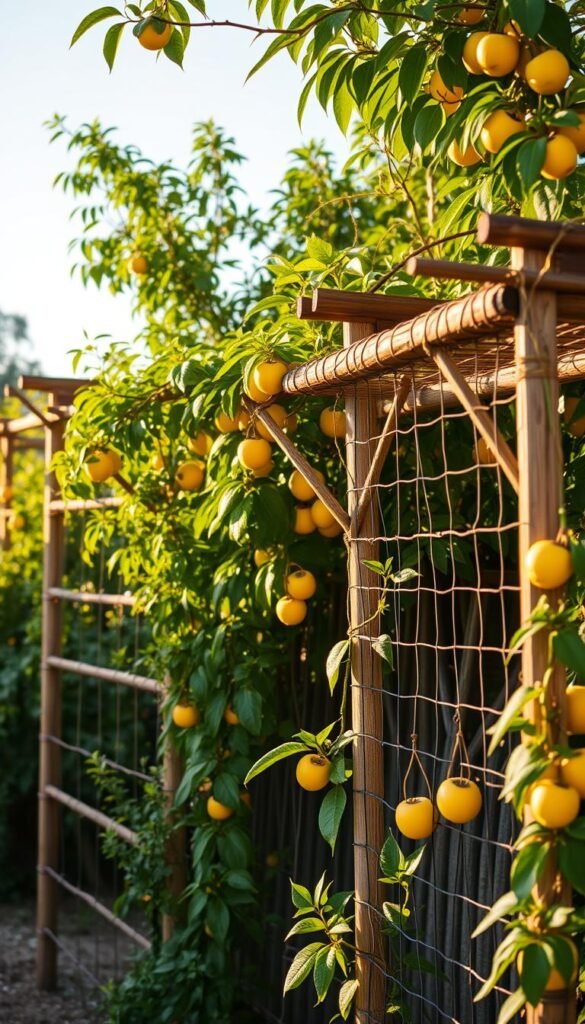
Turn forgotten items into functional garden art. Upcycled structures save money while reducing waste – a win for your wallet and the planet. With basic tools and creativity, you’ll craft supports that last 3-5 years in most growing zones.
Bamboo, Ladders, and Chicken Wire Solutions
Bamboo’s natural strength makes it perfect for curved arches or grid patterns. Lash poles together with zip ties, creating custom shapes that fit your location. For quick setups, lean old ladders against walls and secure them with stakes.
Chicken wire stretched between posts forms an ideal climbing surface. Use 2″ mesh for easy tendril gripping. One gardener shared:
“My son welded cattle panels into two-sided screens using repurposed pipes. At $12 per panel, they’ve supported grapes for 4 years without bending.”
Incorporating Repurposed Pallets for a Creative Touch
Disassemble wooden pallets to build vertical gardens. Remove every third slat for vine access, then sand rough edges. Seal with weatherproof stain, and attach to fence posts for instant height.
| Material | Cost | Lifespan | Best Use |
|---|---|---|---|
| Bamboo | $0-$20 | 3-5 years | Curved designs |
| Wooden Ladders | Free-$30 | 2-4 years | Vertical growth |
| Chicken Wire | $15-$40 | 5+ years | Wall systems |
| Pallets | Free-$10 | 3-7 years | Freestanding screens |
Mix materials for hybrid designs. Combine bamboo frames with wire mesh, or add pallet parts to ladder structures. Your plants will thrive while you enjoy unique, earth-friendly creations.
Store-Bought Trellis Options and Where to Find Them
Ready-made supports offer instant solutions for gardeners seeking both function and style. From expandable grids to ornamental arches, today’s market delivers solutions matching every garden’s personality and budget.
Budget-Friendly Selections for Every Garden
Gardening Express stocks adaptable systems like their 6-foot expanding model ($45) that grows with your vines. Homebase provides treated wooden panels ($32) ideal for fence attachments, while Wickes offers durable fence-top lattices perfect for tight spaces.
Look for powder-coated steel designs at B&Q ($55-$90) that withstand coastal air. These options balance affordability with 3-5 years of reliable service in most climates.
High-End Designs for a Stylish Look
The Garden Trellis Co crafts architectural pieces like their slatted cedar screens ($249), while John Lewis sells sleek steel arches ($179) that become permanent landscape features. Robert Dyas features handwoven willow panels ($89) adding organic texture.
Premium systems often include:
- Galvanized steel joints resisting rust
- Pre-drilled holes for swift installation
- 10-year warranties against weather damage
| Feature | Budget Option | Premium Option |
|---|---|---|
| Price Range | $30-$90 | $90-$300+ |
| Materials | Treated wood, basic metal | Cedar, stainless steel |
| Lifespan | 3-5 years | 7-12 years |
| Best For | Temporary setups | Permanent installations |
Online retailers like Thompson & Morgan simplify comparisons with customer reviews and delivery tracking. Whether you prioritize quick setup or lasting beauty, today’s variety ensures your location gets exactly what it needs.
Integrating Trellis with Container Gardening
Growing vertically in pots brings big rewards for space-conscious growers. Containers with integrated climbing systems let you cultivate lush vines anywhere – patios, balconies, or urban rooftops become productive spaces.
Choosing the Right Container with Built-In Support
Look for planters featuring sturdy metal frames or woven willow panels attached to their sides. These designs eliminate guesswork – simply train tendrils onto ready-made structures. Self-watering models with trellis attachments work best for consistent moisture needs.
Material matters. Fiberglass pots resist cracking in freeze-thaw cycles, while cedar boxes blend natural aesthetics with durability. Ensure containers measure at least 18″ wide to handle mature root systems. Pair with lightweight expanded clay pellets at the base for improved drainage.
Secure freestanding units against wind with cross-braced legs or weighted bases. For wall-mounted options, use corrosion-resistant brackets that hold 50+ pounds when fully grown. This smart fusion of form and function keeps your potted plants thriving season after season.

